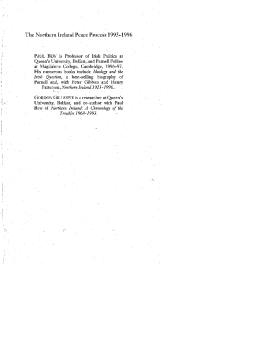
Additional Information
Book Details
Abstract
For those who knew how to read them, some very interesting smoke signals emerged from Northern Ireland during the summer of 1993. Despite all manner of official denials and obfuscation, it was clear that there were moves afoot to bring an end to the violence which had plagued the province for a quarter of a century.
On 31 August 1994 the IRA announced a ceasefire and for almost eighteen months the headlines were of negotiations in Dublin, handshakes in Washington and talks between Sinn Fein and the British government. Peace had broken out. There followed a series of discussions which eventually foundered on the rock of decommissioning military arms. Then in February 1996 bombs in Docklands and elsewhere in London brought the peace process to a sudden and bloody end. Although elections to a peace forum were held in May 1996, the renewed violence and tension of that summer's marching season seriously damaged any lingering hopes of a return to peace.
The Northern Ireland Peace Process 1993–1996: A Chronology records the developments those hopeful years, charting inter-governmental talks, seemingly minor incidents whose significance became apparent only months later and dramatic political shifts and turns. Explanatory essays about the major turning points in the peace process are woven into a political diary which has become the book on the subject.
'The best single volume summary of Northern Ireland's notoriously tortuous political and military situation'
The Irish Times
'Students will appreciate its meticulous assembly and clear, even-handed presentation of the facts'
The Scotsman
'It is the first book to give an overview of the Irish peace process from its beginnings in rumours of secret talks to its bloody demise at Canary Wharf and Portadown.'
History Today
